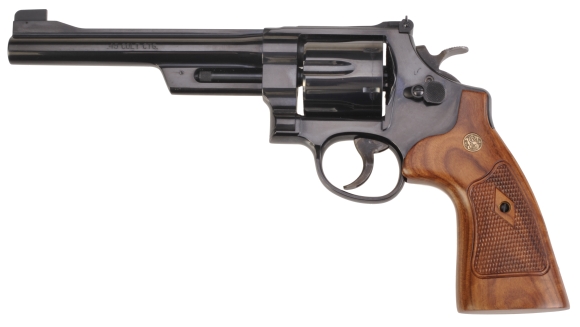
I handload the 45 Colt for both handguns and rifles, often pushing 32,000 PSI where firearms are designed to hold up to this level of excessive pressure. However, all firearm designs for the .45 Colt cartridge are not equal and some should be kept to SAAMI industry standards. The Colt Single Action and current generation small frame Ruger Vaquero immediately come to mind as SAAMI spec guns. On the other end of the spectrum are the Ruger Blackhawks and Freedom Arms single action revolvers and Colt Anaconda and Dan Wesson and Ruger Redhawk on the double action front. The S&W Model 25 appears to reside somewhere in between the two groups.
The strength and pressure conundrum…
Smith & Wesson customer service was contacted and asked if the Model 25 Classic could be used with +P rated commercially loaded .45 Colt ammunition. The response was, “All new production S&W revolvers are safe to use with +P ammunition”, but with the caveat that the +P designation is stamped on the barrel next to the cartridge designation. There is no such stamp on the Model 25 Classic and the Model 25’s manual indicates “Never use cartridges other than those designated by the markings on the barrel”. The conclusion was that the customer service agent was making a more general statement that needed to be supported with a +P indication on the specific firearm.
From the perspective of ammunition manufacturers, Cor-Bon tech support indicated that their +P ammunition should be OK for use in the current Model 25. Buffalo Bore tech support said that only their standard pressure ammunition and specifically SKU: 3D/50 Heavy .45 Colt +P Ammo – 300 gr. JFN are for use in the Model 25, indicating that the rest of their +P ammunition was too powerful for N frame use. No reloading manuals include, but some specifically exclude, the Model 25 from use with high pressure 45 Colt reloading data that is intended for less than a handful of firearms.
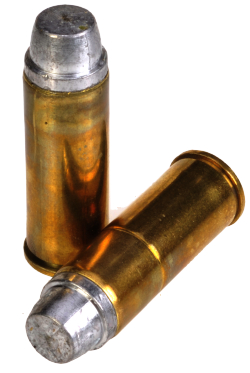 The .45 Colt has a SAAMI maximum pressure specification of 14,000 PSI, a level of strain I am sure the Model 25 can endure for a shooter’s lifetime and for future generations that follow. However, there is a good amount of ammunition being offered by manufacturers that is designated “+P”, identifying the ammo as loaded to a maximum pressure higher than the original specification. As an example, SAAMI specified .45 ACP maximum pressure is 21,000 PSI. The 45 ACP +P maximum pressure is 23,000 PSI. There are a number of cartridges that carry a +P designation, each with a published industry standard maximum pressure.
The .45 Colt has a SAAMI maximum pressure specification of 14,000 PSI, a level of strain I am sure the Model 25 can endure for a shooter’s lifetime and for future generations that follow. However, there is a good amount of ammunition being offered by manufacturers that is designated “+P”, identifying the ammo as loaded to a maximum pressure higher than the original specification. As an example, SAAMI specified .45 ACP maximum pressure is 21,000 PSI. The 45 ACP +P maximum pressure is 23,000 PSI. There are a number of cartridges that carry a +P designation, each with a published industry standard maximum pressure.
The problem with a .45 Colt +P reference is that there is no such industry standard. The +P designation is being applied by manufacturers to identify the ammunition as being loaded above SAAMI standard pressure levels, but to a degree lacking quantification. Please don’t email to tell me you have read in a Wiki article, or on a reloading oriented web site, that there is SAAMI 45 Colt +P or 45 Colt (Ruger data) specification unless you also have a current and official SAAMI document that supports the existence of a 45 Colt +P standard.
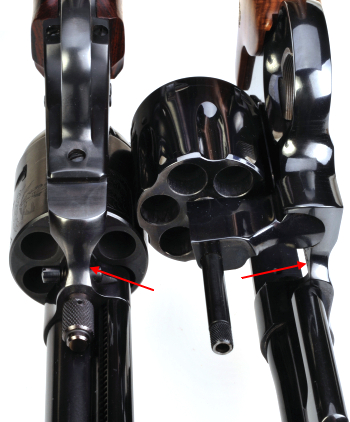
The S&W’s cylinder diameter is 1.715″, the walls are 0.0860″. By comparison, the .45 Colt chambered, unfluted Ruger Bisley cylinder is 1.736″ in diameter and 0.105″ thick at it’s thinnest point. The S&W frame, adjacent to the crane and well right of bore centerline, is 0.241″. The Ruger frame, below the base pin and centered in alignment with the gun’s bore, measures 0.274″.
John Linebaugh has written that the Model 25-5 cylinder is virtually the same diameter and web dimensions as the standard Ruger Blackhawk and offers the same degree of strength. He felt handloads for the Model 25-5, should be kept below a 32,000 PSI. If I understand Linebaugh’s conclusions, he expressed the Model 25 double action frame is inherently weaker than a single action frame and, what he termed “soft frames” stretched under excessive pressure, causing the gun to rapidly developed excessive cylinder end shake.
There have been some improvement to the Model 25 since Model 25-5 production. In 1988, a new yoke retention system was implemented and the gun’s cylinder received a longer stop notch. In 2001, the Model 25 received a newly designed frame with a floating firing pin, extended cylinder stop lug, Metal Injection Molded trigger and hammer, and revised internal lockwork. Much of this works to prevent the cylinder from popping open under recoil and to reduced cost and improved strength and reliability. I do not know, to what degree, the frame or cylinder are processed, heat treated, for greater strength.
Handloads for the Model 25
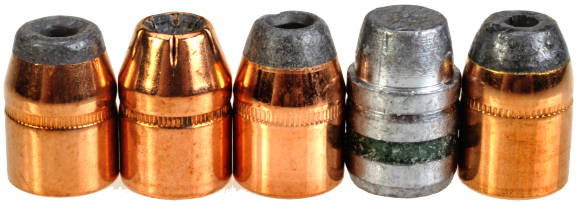
The bullets selected above, are in the order they appear in the table below. I believe a bullet weight range that runs from 240 – 260 grains is appropriate for the pressure levels maintained, so I dispensed with very heavy cast bullets I might load for the Ruger single action Blackhawk or T/C Contender.

|
Warning: Bullet selections are specific, and loads are not valid with substitutions of different bullets of the same weight. Variations in bullet material and length will alter net case capacity, pressure and velocity results. Primer selection is specific and primer types are not interchangeable. These data represents maximum loads in our firearms and test equipment and may easily be excessive in other applications. All loads should be reduced and developed following safe handloading practices as represented in established reloading manuals produced by component manufacturers. Presentation of these loads does not constitute a solicitation for their use, nor a recommendation.
|
||||||||||||
| COL and Capacity | Load Data & Performance | ||||||||
| Bullet Type | Bullet Weight |
C.O.L. Inches |
Net Grains Water |
Powder | Charge Grains |
Muzzle Velocity FPS |
Muzzle Energy Ft/Lbs |
Group Size “ |
|
| Sierra JHC | 240 | 1.600 | 29.42 | Power Pistol | 10.0 | 1002 | 535 | 1.4 | |
| Sierra JHC | 240 | 1.600 | 29.42 | Blue Dot | 12.5 | 947 | 478 | 1.7 | |
| Sierra JHC | 240 | 1.600 | 29.42 | 2400 | 15.6 | 1015 | 549 | 1.0 | |
| Hornady HP/XTP | 250 | 1.595 | 28.084 | Power Pistol | 9.5 | 951 | 502 | 1.1 | |
| Hornady HP/XTP | 250 | 1.595 | 28.084 | Blue Dot | 12.5 | 953 | 504 | 1.3 | |
| Hornady HP/XTP | 250 | 1.595 | 28.084 | Lil’ Gun | 20.0 | 1017 | 574 | 1.1 | |
| Nosler JHP | 250 | 1.600 | 27.72 | AA 9 | 14.5 | 959 | 510 | 1.5 | |
| Nosler JHP | 250 | 1.600 | 27.72 | 2400 | 15.0 | 982 | 536 | 1.6 | |
| Nosler JHP | 250 | 1.600 | 27.72 | Lil’ Gun | 20.0 | 1028 | 587 | 1.3 | |
| Oregon Trail SWC | 255 | 1.600 | 27.19 | AA9 | 15.0 | 977 | 541 | 1.9 | |
| Oregon Trail SWC | 255 | 1.600 | 27.19 | Power Pistol | 10.0 | 994 | 559 | 1.7 | |
| Oregon Trail SWC | 255 | 1.600 | 27.19 | 2400 | 15.5 | 1001 | 567 | 1.4 | |
| Oregon Trail SWC | 255 | 1.600 | 27.19 | Lil’ Gun | 20.5 | 1030 | 600 | 1.7 | |
| Speer JHP | 260 | 1.590 | 27.20 | Power Pistol | 9.5 | 958 | 530 | 1.8 | |
| Speer JHP | 260 | 1.590 | 27.20 | Blue Dot | 12.5 | 952 | 523 | 1.7 | |
| Speer JHP | 260 | 1.590 | 27.20 | 2400 | 14.5 | 954 | 525 | 1.2 | |
| Speer JHP | 260 | 1.590 | 27.20 | Lil’ Gun | 19.5 | 1008 | 587 | 1.3 | |
The twenty five yard groups were shot from a cradle rest to get as close to the mechanical performance of the Model 25 as possible, But then there are my eyes and breathing behind the sights. I would define the gun as accurate with more potential. No, the loads aren’t enough to jar fillings loose, but I bet they are more than enough to drop a deer in close cover, more than enough for self defense and too much for volume target shooting by a couple hundred feet per second.
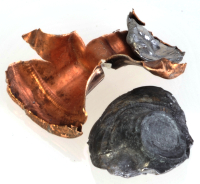 The defense only bullet on the table is the Hornady. They just open up too quickly and leave their energy in a shallow target. This one was pulled from 2″ into a 3″ dry slick paper target. By comparison, the Oregon Trail bullet blew through and left a 2″ exit. I did run some handloads with heavier bullets, including a 300 Hornady that pushed through the catalog with no problem, but velocity dropped to approximately 850 fps, energy fell to 500 ft/lbs and recoils was increased. At this weight I’d probably just go with a hard cast flat point 300 grain bullet that would probably shoot through a moose. With rounds of this type, kinetic energy is much less important than momentum, penetration and accuracy.
The defense only bullet on the table is the Hornady. They just open up too quickly and leave their energy in a shallow target. This one was pulled from 2″ into a 3″ dry slick paper target. By comparison, the Oregon Trail bullet blew through and left a 2″ exit. I did run some handloads with heavier bullets, including a 300 Hornady that pushed through the catalog with no problem, but velocity dropped to approximately 850 fps, energy fell to 500 ft/lbs and recoils was increased. At this weight I’d probably just go with a hard cast flat point 300 grain bullet that would probably shoot through a moose. With rounds of this type, kinetic energy is much less important than momentum, penetration and accuracy.
Something a little special…
I like the gun. It feels like something altogether different from a single action revolver and it feels like good Smith & Wesson revolvers from years past. Click, click, click… hammer cocking, cylinder rotating, sights adjusting. A nice precise machine with good shooting qualities. Reminds me of all of those old gun writers from the west and mid west who actually knew how to shoot a revolver and didn’t try to make up for poor shooter performance with a gun that held two boxes of ammo.
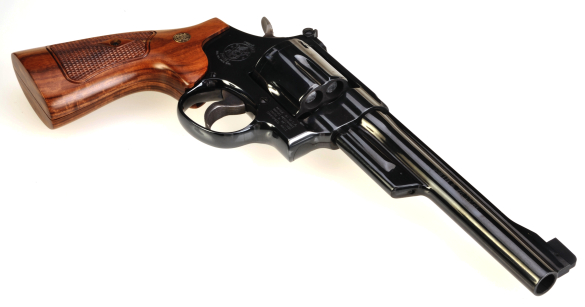
For someone looking for a big bore revolver that isn’t punishing to shoot, but has enough steam to drop deer size game or to provide a hunter with open carry protection, the Model 25 is an excellent choice. The Model 25 also fits in nicely for home protection or for recreational target shooting. The quality of parts and assembly, as well as the gun’s overall appearance and function, all instill pride of ownership. Good gun.
An N Frame Big Bore… Without Dirty Harry Part I
An N Frame Big Bore Without Dirty Harry Part II

Email Notification